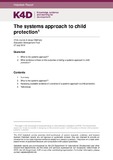| dc.contributor.author | Joynes, Chris | |
| dc.contributor.author | Mattingly, Jacqui | |
| dc.coverage.spatial | Cambodia | en |
| dc.coverage.spatial | Lao PDR | en |
| dc.coverage.spatial | Papua New Guinea | en |
| dc.coverage.spatial | Albania | en |
| dc.date.accessioned | 2019-01-03T10:02:49Z | |
| dc.date.available | 2019-01-03T10:02:49Z | |
| dc.date.issued | 2018-07-27 | |
| dc.identifier.citation | Joynes, C. & Mattingly, J. (2018). A systems approach to child protection. K4D Helpdesk Report. Brighton, UK: Institute of Development Studies | en |
| dc.identifier.uri | https://opendocs.ids.ac.uk/opendocs/handle/20.500.12413/14222 | |
| dc.description.abstract | This purpose of this review is to identify the outcomes of taking a systems approach to child protection by basing on six days of desk-based research. There are four basic principles of design reflectedin the system-based approaches to child protection services in a development context. First, organising all systems components around a common goal or vision in order to provide the strategic direction for system implementation (Delaney et al. 2014: 13; Wulczyn et al. 2010: 2, 11). Second, defining the activities of each system on the basis of a specific set of functions, structures and capacities that interact and influence each other (Wulczyn et al 2010: 2, 12-13; Delaney et al. 2014: 13), while also establishing clear systemic boundaries, roles and responsibilities in order to ensure accountability and good governance (Delaney et al. 2014: 14). Third, involving a wide range of different actors as part of the system, including across and within sectors in horizontal and vertical networks (Delaney et al. 2014: 13; Wulczyn et al. 2010: 10). And fourth, ensuring that the shape, functions and actions of the system should always be grounded in the context in which it operates, and make sense to the communities who are the end users (Wulczyn et al. 2010: 2, 11). There is limited evidence of the impact of a systems approach to child protection in a development context. Across many contexts and national settings, the consensus is that the necessary legal and policy frameworks for child protection are in place at national level, but programme implementation and service delivery still lags far behind (Stuckenbruck 2018: 12). This review noted that there is a significant gap in the availability of evidence, making an assessment of the impact of a systems approach extremely difficult (Krueger et al. 2014; Krueger 2014: 30; Stuckenbruck 2018). Additionally, much of the research and monitoring and evaluation focuses on systems-development programmes delivered by international agencies, rather than on national state-led child protection systems. Within the time available, the review was only able to identify limited examples where overviews of child protection systems development inputs are accompanied by evidence of impact on child protection, rather than just outcomes in terms of targets associated with systems strengthening. | en |
| dc.language.iso | en | en |
| dc.publisher | IDS | en |
| dc.relation.ispartofseries | K4D Helpdesk Report;399 | |
| dc.rights.uri | https://www.nationalarchives.gov.uk/doc/open-government-licence/version/3/ | en |
| dc.subject | Children and Youth | en |
| dc.subject | Education | en |
| dc.subject | Health | en |
| dc.subject | Participation | en |
| dc.subject | Social Protection | en |
| dc.title | The Systems Approach to Child Protection | en |
| dc.type | Other | en |
| dc.rights.holder | © DFID - Crown copyright 2018. | en |
| dcterms.dateAccepted | 2018-07-27 | |
| rioxxterms.funder | Department for International Development, UK Government | en |
| rioxxterms.identifier.project | K4D | en |
| rioxxterms.version | VoR | en |
| rioxxterms.funder.project | 238a9fa4-fe4a-4380-996b-995f33607ba0 | en |

